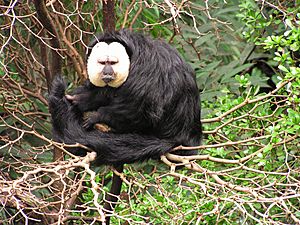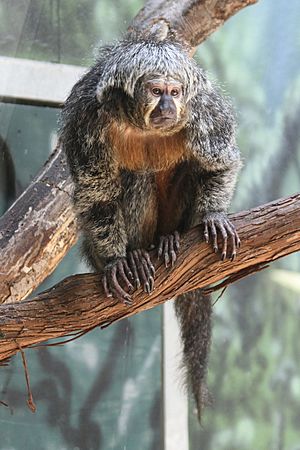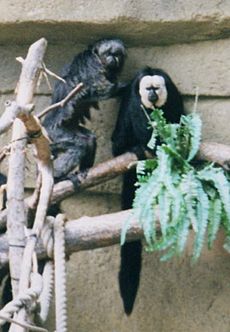White-faced saki facts for kids
Quick facts for kids White-faced saki |
|
|---|---|
 |
|
| Male | |
 |
|
| Female | |
| Conservation status | |
| Scientific classification | |
| Genus: |
Pithecia
|
| Species: |
pithecia
|
 |
|
| White-faced saki range | |
| Synonyms | |
|
|
The white-faced saki (Pithecia pithecia) is a type of saki monkey found in South America. People also call it the Guianan saki or the golden-faced saki. These monkeys live in countries like Brazil, French Guiana, Guyana, Suriname, and Venezuela.
White-faced sakis spend most of their lives in trees. They live in the lower parts of the forest, moving between branches. They are amazing at swinging from tree to tree, a skill called brachiation. But they also come down to the ground to find food. They mostly eat fruits, nuts, seeds, and insects. In the wild, they usually live for about 14 years. However, some have lived much longer, up to 36 years, when cared for by humans. Sakis are active during the day. At night, they sleep high up in leafy trees, usually 15-20 meters off the ground. This helps keep them safe from bad weather and predators that fly.
Scientists once thought a different type of saki, P. chrysocephala, was just a subspecies of the white-faced saki. But in 2014, they decided it was a completely separate species.
Contents
Reproduction and Life Cycle
In zoos, female white-faced sakis have a pregnancy period of about 20 to 21 weeks. After giving birth, the mother usually cannot get pregnant again for about 23 weeks. This happens while she is nursing her baby. White-faced sakis typically breed once a year, usually in the spring. They almost always have only one baby at a time.
White-faced sakis show clear differences between males and females. This is called sexual dimorphism. They differ in their fur color and also in size. Females have shorter, brownish-grey fur. They have white or pale brown stripes around their nose and mouth. Males, on the other hand, have much blacker fur. Their forehead, face, and throat are reddish-white, making their faces look much whiter than females. Males are also bigger than females. They can weigh about 500 grams more.
Young male sakis can sometimes look like females. This is because their back fur might be "grizzled" (mixed colors) and their bellies might be orangish. It takes about two months for males and females to start looking different. These differences become very clear over a few years.
Behavior and Social Life
White-faced sakis are known for being very loyal to their partners. A male and female saki often stay together for their whole lives. They strengthen their bond by grooming each other. Male saki monkeys are usually more active than females.
Scientists believe they are monogamous, meaning they mate for life. However, it's hard to study them for long periods. Their group sizes can change, which makes some scientists wonder if their behavior is always "typical monogamy." One study in South America showed that their group numbers can range from 2 to 12 members. Larger groups are often seen in Guyana. But most observations show them traveling in small groups of 2 or 3. These groups usually include the parents and their young. They travel about 0.5 to 1.25 miles each day. They search for food and other things in the early morning and during the day, when they are most active.
How They Move
White-faced sakis move differently from many other primates. This includes their close relative, the Chiropotes satanas. They are mostly leapers, which means they jump a lot. About 70 percent of their travel time is spent leaping. The other 30 percent is spent walking and running on all fours (25 percent) and climbing (less than 5 percent).
What They Eat
These primates travel longer distances than many other monkeys. They can also be picky about their food sources. They prefer trees that produce a lot of fruit. They also like Capparis trees and trees with water holes. Sakis have a varied diet. They eat seeds, fruits, leaves, honey, flowers, insects, and even small mammals and birds. They often eat seeds and plants that are rich in fats. They have also been seen crawling into hollow trees to eat bats that live there. They can do this because they have large canine teeth. These teeth help them crack open the hard shells of nuts and other foods.
Predators and Defense
If a predator is nearby, white-faced sakis will make loud alarm calls. These calls can last from over a minute to more than an hour. One saki will start the call, and others will echo it to spread the warning. They will then puff up their bodies. They also stomp their feet on the ground or trees. This is an attempt to scare away the threat.
White-faced sakis are small monkeys that live in tree branches. So, large birds are a big danger to them. These birds include hawks, vultures, and the powerful harpy eagle. When facing danger, white-faced sakis will either make warning calls or freeze. If they are high in the canopy, they will try to move down where they are out of sight.
Their reaction to a predator depends on the type of threat. If it's a smaller, weaker threat, the group will "mob" the predator. This means they will work together to scare it away. But if the threat is larger, like an eagle, they will not make warning calls. Instead, they will quietly go down into the lower parts of the trees to hide. Other predators that live on the ground or in water include the tayra, jaguars, pumas, green anacondas, ocelots, red-tailed boa, and even large mustelids. These animals usually threaten the young and older sakis.
See also
 In Spanish: Saki cariblanco para niños
In Spanish: Saki cariblanco para niños



